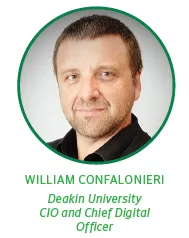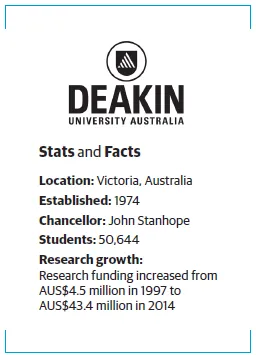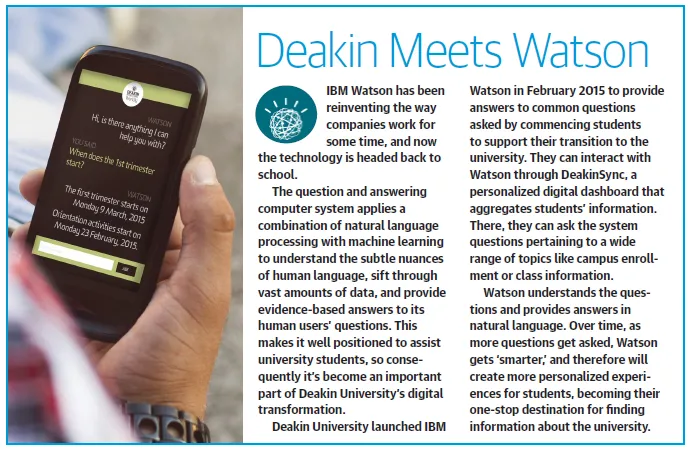At Australia’s Deakin University, the path to achieving a digital mindset is much like the journey to obtain a degree: it is replete with risks and opportunities at every turn and consists of potential shifts in focus along the way.
William Confalonieri, the university’s CIO and Chief Digital Officer, best understands the intricacies of the digital paradigm in education and believes that digital technologies will further transform the student-university relationship in the near future. First and foremost, the delivery of education will serve as a forthcoming monumental change, with digital technologies enabling more students to take classes, collaborate with others, conduct research, and complete activities remotely.

Confalonieri, winner of ITNews’ CIO of the Year in 2014, recently discussed the characteristics essential to a sustainable digital future, the necessary principles for digital excellence, and the benefits of “horizontality.”
Customer Strategist: As the CIO, what challenges do you face in convincing colleagues to take on a digital mindset?
William Confalonieri: There is no need of convincing people to move to a digital mindset. The challenge resides in defining what exactly a digital mindset is for a specific business and in understanding how to go there. A digital mindset, in general, challenges organizational arrangements and consolidated practices. The next challenge then is to execute the transition.
CS: What are some digital initiatives happening at Deakin University?
WC: [Digital transformation] is a journey that takes an organization, over a reasonable period of time, from its current state to become digitally mature. The path to digital maturity consists of two interweaving processes: The first one is about achieving digital performance, while the second involves the conversion of the organization’s DNA. Characteristics, performance, and essence are necessary for a sustainable digital future.
At Deakin University we have been working on several projects to upswing the digital performance. Personalization, cognitive computing, augmented reality, and the Internet of Things are some of the bleeding-edge concepts that we have incorporated in some of our platforms. As an example, we are the first university in the world to have IBM Watson providing advice and support to our students (see sidebar at bottom).
CS: How do you help enable an omnichannel experience?
WC: Omnichannel is a way to say the digital experience is one not many, which is quite obvious. It is part of the essence of being digitally focused. In particular, I never use the concept of ‘omnichannel’ since I assume it is a requirement when any digital strategy is discussed. The digital experience is horizontal, crossing over not only the channels, but also the business functions and the information towers. ‘Horizontality’ is a much more powerful concept than omnichannel.
CS: What are the enablers of a digital, horizontal organization?
WC: In the new world, we need to move faster. And speed generally causes fractures in the organizational fabric if it has not aerodynamically prepared itself. At high speed, even small fractures become dangerous. To give the organization the aerodynamics required for the digital race is the most difficult part of the transformation, because it involves people and organizational arrangements, and the way we perceive, think, understand, and do things.
Digital excellence demands respect for three essential principles:
- Premium experience must be delivered across all digital customer touchpoints.
- Information must be consistent and available where and when needed.
- Each system and process must be considered a gear of a much more complex machine.
- We need to force ourselves to think in a different way because digital is unlike anything we have encountered before. Digital DNA is about leadership and thus an organizational problem. It is not about technology. It requires shifting the focus from internal structures to stakeholders.
CS: What are some challenges you’ve encountered along your journey to become more digitally and horizontally focused?

WC: The typical organizational approach focuses on partial experiences and parts of the information, and on those things that maximize functional performance but not necessarily organizational performance. Organizations usually build systems in functional towers, based on what process they need to automate and what function they need to do for their business.
Governance arrangements, key performance indicators, bonuses, recognitions, auditing processes, and many organizational controls and incentives center on vertical structures. They tend to prioritize functional delivery, generally not observing the fragmentation of the organizational “info-structure” or effects on the smoothness of the digital touchpoint transitions.
Digital requires new thinking and new thinking usually doesn’t come naturally. Our learning and instincts might deceive us, as they have operated for so long under a different paradigm. Often organizations assemble information and digital content around the departments that manage them. This creates siloed information architecture that rarely reflects the way customers think.
CS: How are students’ expectations of the university’s digital experiences evolving?
WC: The expectations of students are not different from the expectations of any organizations’ customers. We live in an age of pervasive computing. New technologies have a growing ripple effect across work, study, social, and private activities. Now a core part of our lives, technology blurs previously well-defined borders between different aspects of our days and shifts power from organizations to individuals. Additionally, technology has evolved to a point where it enables us to move from digital transactions to digital relationships. Students expect us to deliver rich, inspiring, holistic, intimate, powerful digital experiences.
CS: How will digital technology transform Deakin University in the coming years?
WC: I believe that new technologies, in particular high levels of personalization supported by artificial intelligence and virtual reality, will change education delivery substantially, making in many cases the digital experience far superior to whatever could be reached by non-digital means. The balance between the on-campus and at-home activities will be dramatically altered in my view.
CS: What’s the one digital solution that you want to implement in the coming year that you think will transform the way students and the university interact and engage?
WC: It is amazing and I am very excited about it. It is certainly a competitive advantage and I am not able to discuss it until we have it ready for the market.
















